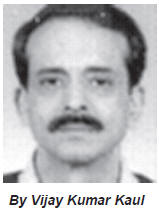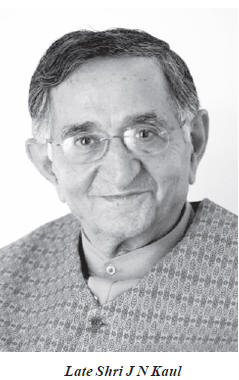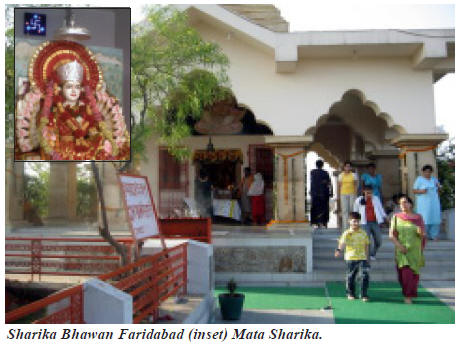JN Kaul
Hard Times: A Helping Hand and a Beacon of Light
By Vijay Kumar Kaul
 When 'Papa Ji' - PadmaShri Shri J N Kaul passed away on December 16, 2008, after a relatively brief illness, social and community activists from all over the world joined his family and friends in mourning his loss and remembering his contributions. How does one add to the chorus of people and organizations who have already so passionately and eloquently expressed the profound loss of this great social activist and the tallest of tall sons of the Kashmiri community? When asked to write this tribute by Panun Kashmir, I felt honoured to document my memories of this great Icon who was perhaps the tallest if we look back two centuries in History and who will be remembered for centuries for the indelible marks that he has left in the History of time.
When 'Papa Ji' - PadmaShri Shri J N Kaul passed away on December 16, 2008, after a relatively brief illness, social and community activists from all over the world joined his family and friends in mourning his loss and remembering his contributions. How does one add to the chorus of people and organizations who have already so passionately and eloquently expressed the profound loss of this great social activist and the tallest of tall sons of the Kashmiri community? When asked to write this tribute by Panun Kashmir, I felt honoured to document my memories of this great Icon who was perhaps the tallest if we look back two centuries in History and who will be remembered for centuries for the indelible marks that he has left in the History of time.

The creation of SOS Children's Villages of India as the largest Children's NGO in India is widely known. In the early 80's, the SOS office was situated in Nehru Place. This is where I had my life's first glimpse of Shri J N Kaul, most smartly dressed, carrying a brief case, and catching the lift to his office sharp at 9 A.M, every morning. Nehru place in New Delhi had so many corporate offices those days, but the likes and looks of Kaul Sahib made him look different as the best dressed and the most 'impressive' business executive one could find in this bustling business hub. I knew nothing more of Kaul Sahib those days except for the fact that he was heading a Children's organisation. However, at the very first sight he looked a distinct personality that easily commanded great respect.
Then came the early 90's that brought to the Community winters of discontent and a period of 'great depression'. The displacement and Diaspora brought to the fore many well meaning community members who felt deeply disturbed and shaken up with the sufferings of their own community and life of destitution and misery that settlement in tenements of Jammu had brought along. One of these 'sensitive' minds was Shri J N Kaul. When approached by Kashmiri Sewak Samaj, Faridabad in 1992 to head as its President, he felt honoured to accept it. Kaul Sahib, as one of his first major acts of memorable contributions, joined hands with All India Kashmiri Samaj and placed at their disposal the resources of SOS Children's villages of India for setting up a Centre of Computer learning for the children of Jammu camps. While giving relief to the needy was the norm in those troubled times, Kaul Sahib showed his vision and leadership by practicing in the belief "Do not give them fish but teach them how to catch fish"! This program ran for many years successfully and succeeded in making bread winners for many hundreds of families. When Kaul Sahib donned the mantle of leading AIKS also, the program got a great fillip. The cynics always used to sow doubts about the usefulness of this program and suggested doing this at Jammu, closer to the camps. However, Kaul Sahib persisted and continued getting a few dozen boys and girls recruited every summer, and lodged them in Hostels with modern amenities at Faridabad.

The induced hygiene factor of attending the School in the beautiful environs of SOS campus always had a metamorphosis effect on the camp children's personality. During the early years of 90's, many young men and women also were given employment in various SOS schools and thus many a families were saved from economic hardships in those years of despair. Kaul Sahib also set up Hostels for working girls in Noida, who were helped to get jobs in industries in this area. Perhaps, this combined activity of rehabilitation launched by the great visionary was the most commendable non-governmental effort at that point of time. Every Sunday, Kaul Sahib used to visit these Hostels in Noida and verify the safety, security and well being of the Community daughters living there.
With the initial pain of displacement subsiding a bit, Kaul Sahib started formulating a blue print for Institution building in the mid 90's. This is where he left an indelible mark in the history of Kashmiri Pandits. "Mochi Fouli Saet Athrot" concept of saving a bit with the aim of giving was very dear to Kaul Sahib's heart. For the tenure of his 15 years of service to his community, he always talked and reminded of saving for our less fortunate brothers and sisters. In this he used to lead by example. Every month, 'Mimmi' Smt. Indira Kaul, wife of Kaul Sahib would deposit her family contribution with the treasurer in KSS. As General Secretary of KSS, I am witness to scores of men and women who used to call on him from all over to seek succour and help. Some of them used to be terminally sick. Kaul Sahib used to treat them with courtesy and humility. Help was not given with the normally practiced trait of "good riddance". He would delve deep and enquire how the family of the needy person could be helped to augment resources for long term survival. Alas, Kaul Sahib's continued exhortation to the community to develop a permanent global corpus for help to the needy has remained yet an unfulfilled dream. Seeing the lack of needed focus within the Community on this pressing humanitarian need, Kaul Sahib towards his last days even was toying with the idea of starting a family trust called 'Athrot". The idea didn't travel far as Kaul Sahib fell sick soon after.

In the mid-90's, Kaul Sahib unveiled his grand vision of Institution building and gave birth to the idea of building Sharika Bhavan and Hari Parbat in the district of Faridabad. Sceptics were full of doubt and pooh poohed both the projects. Sharika Bhawan was allotted a plot of land by Govt. of Haryana for a sum of Rs. 3 Lakhs close to the famed Rose Garden of Sector 17. The Organisation had no money to buy the plot of land. Kaul Sahib made the entire KSS executive to give personal bonds for raising this sum. The same was submitted to Haryana Urban Development Authority, who were quick to allot the land in a prestigious place in a central location. When Kaul Sahib unveiled his plans and submitted the Architects plans of building a multi-purpose Community centre at a cost of Rs. 1 core, it was met with doubts and cynicism. The advice from all quarters was to build something 'affordable, cheap and low cost- Shrogh Shrogh ta Panahdhar''! Unmindful, Kaul Sahib continued with his thoughts. I recall, as the General Secretary of Kashmiri Sewak Samaj, he asked me to send out the first appeal to the Community, far and wide. He took great pains to guide me in a making a brochure to help sell the idea of necessity of having Sharika Bhawan. The initial responses that we received, though meagre in contributions, gave us some hope. In close confidence, Kaul Sahib once told me that he believed Rs. 1 Crore was not too big a sum for the community. However, if the community could not afford it, he could get it done single handed. Despite all odds, he announced the foundation laying ceremony of Sharika Bhawan. It was attended by 70 people from NCR. Kaul Sahib gave a contribution of Rs. 5 Lakhs that he had been given by SOS to fulfil his cherished desire of building a Hostel for girls within Sharika Bhawan. This very handsome donation by Kaul Sahib helped start the work and there after, some philanthropic minds contributed many times this amount and helped build Sharika Bhawan in a record time. The Executive members of KSS were so excited with this project that they all individually contributed significantly to set personal example to the masses. Sharika Bhavan today is mark of Kashmiri Pandit identity in entire Haryana.
Simultaneous to building Sharika Bhawan, Kaul Sahib embarked upon building Hari Parbat in the Aravali hills at village Anangpur in Faridabad. The idea to build Hari Parbat was spurred by 'Mimmi', Shrimati Indira Kaul. She has been an Ardhangani in truest sense of the word for Kaul Sahib. She was always by his side for celebrating or observing any event happy or not so happy. The story is like this. Kaul Sahib and Indira Ji were sitting in the company of Anangpur village elders in the SOS Medical Centre in Anangpur. Indira Ji pointed towards the hillock in front of her and told the gathering that a similar hill in Kashmir was the abode of Ma Sharika, the presiding deity of Kashmiris. So moved were the village elders with the story and the fact that this temple was out of easy reach for the faithful due to displacement that they passed a resolution in the village Panchayat placing the hill at Kaul Sahib's disposal. They wanted him to replicate the Hari Parbat in Anangpur and bring the sleepy village to life. The villagers felt that such a temple in their midst would help build character in their young ones and wean away them from any vices of gambling and drinking.
Kaul Sahib, in order to unveil his plans of building Hari Parbat in Anangpur , announced celebration of Navreh in Anangpur Village and on this day a large procession of village folks and Kashmiris went up the hill wading thorough through thorny hedges. They respectfully listened to Kaul Sahib's grand plans of building Hari Parbat in the rocky and inhospitable terrains of Aravali Hills. However, some minds were full of doubt and disbelief. During this time, some Articles appeared in community magazines charging Kaul Sahib with being a heretic and felt he was indulging in blasphemy. They did not like Hari Parbat of Kashmir to be replicated. Kaul Sahib was clear in his mind. Kashmir was not so easy to reach for the vast majority given the frenzy of intolerance there and he saw Hari Parbat in Anangpur as solace to the vast majority of Kashmiris who had taken refuge in the NCR region of Delhi. He saw this Temple a link to the Original Hari Parbat that Ma Sharika had built when she took the form of a Myna –'Hari' and created a hillock to destroy a demon called "Tchand" who had taken shelter in a remanent of Satisar lake in the vicinity of present Hari Parbat. The demon "Tchand" was so powerful physically that he started shaking the hillock to free himself out of the clutches of Ma Sharika. To destroy the demon, Ma Sharika Herself sat over the hilltop and thus made this place as Her permanent abode. While the Hari Parbat in Kashmir was built by Ma Sharika Herself to alleviate the sufferings of the masses at the hands of demon 'Tchand', it was Shri Kaul who replicated this effort at a time of great suffering and depression that visited us in the twentieth century. Do we say he was a reincarnation of a kind in modern times?
While Sharika Bhawan in sector 17, Faridabad was being built by resources raised from the community, the pace of construction was little slower here than that of Hari Parbat. Sharika Bhawan needed wider consensus at each step of construction while at Hari Parbat Kaul Sahib acted like a one man army, moving the 'mountains in a hurry'. Once the temple was complete, he created a cultural gallery dedicated to Memory of Ma Lalleshwari with her popular sayings carved on black marble plaques.
He even had identified land for building the "Pokhairy Bal" in the vicinity of the Hill. Indraji was the force behind building Swami Vidhyadhar Satsang Bhawan at the footsteps of the Temple. Once when I enquired with Kaul Sahib, how he envisaged that Hari Parbat could run and be managed in future, he said that it was time that the Community started actively taking interest in its upkeep, organising functions periodically to help in keeping it as place of cultural happening and vibrance. Kaul Sahib had many more plans for developing the place further. He had planned to develop an existing kutcha road that would connect the place from the Suraj Kund- Badhkhal Road side. This road would help bypass the village and provide easy access to South Delhi. Prior to one of the Navreh celebrations, he travelled on this Kutcha Road in a Sumo and was full of plans to develop the track into a motorable Road. Perhaps, his health did not permit him to embark on this mission. Every year for the last one decade, Anangpur village sees great festivity when thousands of Kashmiris celebrate Navreh and renew their social bonds. Kaul Sahib wished that KSS and all other NCR organizations would continue to organize this event for all times to come, the way he had led it year after year.
Simultaneous to building the above two centres, Kaul Sahib announced launch of 3 schemes for building housing societies that were named Sabzar, Gayatri and Lalleshwari Vatika. I vividly recall when Haryana Govt. cancelled the Scheme initially; all the members were unanimous in demanding their earnest money back. After seeing this short sighted approach, Kaul Sahib got up to address the gathering and said the opposite of what the majority wanted. He said "consensus is that no one will withdraw money and we will let the housing societies continue". These very Societies helped the members get 4 acres of land allotted a couple of years later. Such was Kaul Sahib's vision and impact on the ordinary minds. They would never disobey him or dare to disagree with him in public. These housing projects took nearly a decade to complete but with all the troubles that Kaul Sahib and his dedicated team of co-workers whom he entrusted with this task had to face, the completion of these Housing Societies is testimony to his vision of grandeur in Architecture, concept of space utilization, amenities and provisions towards ensuring a better quality of life for the Society residents. Kaul Sahib started living in one of the Societies for a few months. He always longed that the residents showed greater depth of understanding, brotherhood and helped create a 'Happy place' for their own sake. This was the purpose of his mission in investing so much of his time and effort in initiating this project. He would often say that his community collectively had become richer by a few hundred crores with this possession, celebrate!
Kaul Sahib also was called on to take the responsiblity of leading Kashmir Education, Cultural and Science Society in Pamposh Enclave. In spite of his not so good a health he accepted it and it is during his time that construction of a cultural centre was started on land that had been allotted to Pamposh Colony residents many decades ago. He brought the Centre to life by organizing events and seminars, periodically.
Kaul Sahib was appreciative for the struggle of Panun Kashmir and was proud of its unmatched activism. He had always hoped for greater thrust to the cause of the movement within the Community.
The achievements of respected Kaul Sahib are numerous to be recounted here in full. In days to come, all of us who have worked with this legendry figure need to document experiences individually lest we lose out on his sagacity and utmost wisdom.
It is hard to write an ending to this tribute to Kaul Sahib. Many years after his death, we will still mourn him, we still will wish we could hear his voice, read his words, and wonder where he will take us next, and we will miss his welcome smile. No doubt, we will discover more visions and more struggles. Like Kaul Sahib, may we see each vision and each struggle as a way to pursue towards excellence for our young ones and unite us to help each other.
Kaul Sahib was a living embodiment of excellence in all walks of life. In every talk and speech he reiterated that the only way for survival was building virtues of excellence in our young ones. He was a stickler for punctuality. In the Sunday prayer that is held at Sharika Bhawan, he was always 5 minutes early. He liked to call social meetings as 'Business meetings' and would conduct them with grace and professionalism that is of rare kind in many Social bodies. Serious business was always interspersed with light humour by him. He was intolerant to side talk and gossip among participants, and would mildly admonish saying "if you have anything interesting, tell this to your President!" Even when he was not in good health in last few months, meetings with his co-workers would bring him cheer and restore him to a jolly mood. He emerged stronger, vibrant and cheerful whenever he got to discuss community issues and projects. There are many ways to honour Pandit J N Kaul Sahib's work and to continue the commitment that he demonstrated while serving the community. May Ma Sharika show us the way!
*(The author is Ex-Gen Secy Kashmiri Sewak Samaj, Faridabad) Source: Kashmir Sentinel


